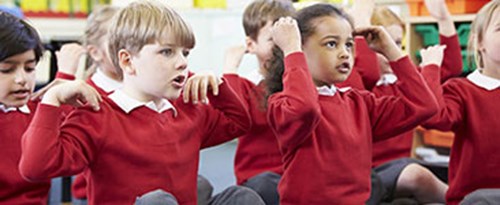Head Shoulders Knees Toes

Les tête, les épaules, les genoux, les doigts de pieds
Les tête, les épaules, les genoux, les doigts de pieds
Les yeux, les oreilles, la bouche et le nez
Les tête, les épaules, les genoux, les doigts de pieds!
Pen, ysgwyddau, coesau a traed, coesau a traed
Pen, ysgwyddau, coesau a traed, coesau a traed
A llygaid a clustiau a trwyn a cheg
Pen, ysgwyddau, coesau a traed, coesau a traed!
Heads, shoulders, knees and toes, knees and toes
Heads, shoulders, knees and toes, knees and toes
And eyes and ears and mouth and nose
Heads, shoulders, knees and toes, knees and toes!
OBJECTIVE: To have fun and warm up the body and voice whilst learning new Welsh, French and English vocabulary for parts of the body. To follow the sound/word pattern in songs and rhymes & develop language skills through songs and rhymes.
Pupils need to be standing and have space around them. Teach them the Head, Shoulders, Knees and Toes song.
Now repeat and replace one body part at a time with the French or Welsh word. Keep going until you have introduced the word for each body part in each language.
Extension
Do the whole song in French and then begin replacing one word at a time with the Welsh word.
Explain that the Welsh words used in this song for knees and toes, (coesau, traed) actually means legs and feet. Ask learners why they think song lyrics might not be translated literally word for word in songs.
Also, have they noticed that in the Welsh verse, the words for mouth and nose are in a different order to the English verse. Does it sound better this way? Why or why not?